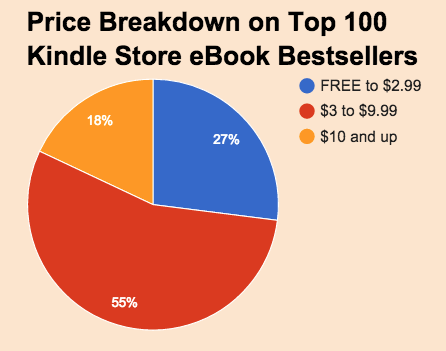by Steve Windwalker – October 13, 2015
Source: BookGorilla’s Annual Analysis of Top 100 Kindle Bestseller Prices
Okay, it’s multiple choice time. Two statements. Please pick one that’s true:
- Traditional publishers’ bestseller prices are rising to ridiculous levels, with an average original price of $11.22 for the Top 100 bestsellers in the Kindle store for the calendar year 2014.
- Traditional publishers are offering over 90% of their top Kindle bestsellers at huge, BookGorilla-worthy discounts, so that, to date, 91 of those Top 100 bestsellers for 2014 have been featured on BookGorilla, at an average price of $2.92.
The answer? Both statements are true.
More that any time since the 2007 launch of the Kindle, the big publishers are taking advantage of discounting incentives offered by Amazon to ensure that nearly every bestseller, and most other books as well, are offered at some point at the kind of low sub-$4 prices that ebook readers have come to love.
The vast majority of the time, let’s be clear, the prices for those same books are much higher.
Equally clear, there is a large swath of readers who are the readers’ equivalent of early adopters. They are eager, one could even say impatient, to buy bestsellers and their favorite authors’ other books when they first come out. They pay mightily to be part of this “be the first on your block” club; if they had purchased all of the Top 100 Kindle bestsellers of 2014 at their original prices, they would have spent $1,121.55. But pay they do, obviously. Otherwise — and here’s this week’s tautology — those Top 100 Kindle bestsellers would not have been on the list.
But by putting nearly all of their most popular books on deep discounts averaging about 73% for short periods of time, usually ranging from one day to a month, the traditional publishers have made bargain-hunting an extremely beneficial exercise for a different group of readers: those who balance their love for bestsellers and other quality selections with very conscious price sensitivity.
By waiting for the right moment and pouncing when these books are at their best prices ever, an especially voracious price-sensitive reader could have purchased the 91 bestsellers featured by BookGorilla for just $265.60. That’s a savings of $731.04 over the $996.44 original cost of these 91 titles. (Some of the other nine books were never offered at a serious discount; some others didn’t make it through BookGorilla’s curating process, in spite of their bestseller status.)
But there’s a catch, of course. Anyone could find those savings on the day they pop up, but you’d have to be looking … and looking … and looking. It would take so much time that there would be little or no time for reading. BookGorilla’s purpose is to find and recognize the best bargains and serve them up to our hundreds of thousands of followers each morning based on subscribers’ selected preferences.
No other ebook bargain alert service has delivered even half of these Top 100 bestseller deals to its subscribers over the past two years, which is why we humbly submit that, along with the Kindle itself, BookGorilla is the one of the greatest lifehacks ever for avid readers. (We also include recommendations for curated 5-star discoveries by indie authors and small or new-media presses, but in stark contrast to other ebook bargain alert services, fewer than 15% of the titles we recommend are ad-supported.)
Who are these price-sensitive readers? Well, we’re not going to give up their names or email addresses, but we’re happy to share some results from our latest BookGorilla 3-Minute Survey on “What Makes an Attractive eBook Bargain?”
We asked the 2,180 readers who have responded during the past week to select the statement that best approximates their approach to this question:
“How important are bargain prices in your decisions about which ebooks to buy?”
Here’s how they responded:
- I often pay full retail prices of $9.99 or above, but I also like to find bargain prices on books that I know I want to read. 136 responses – 6.24%
- Finding bargain prices is essential to my effort to stay on a budget, and I rarely pay full retail prices of $9.99 or above. 654 responses – 30.03%
- I almost never pay more than $2.99 for an ebook purchase. 740 responses – 33.98%
- I rarely download any ebook that is not free. 477 responses – 21.90%
- None of the above. 171 responses – 7.85%
These survey respondents don’t constitute all readers, of course. But they’re our readers, and it’s our mission to make them happy. We wouldn’t want it any other way!
Coming in our next column: Okay, so price-sensitive readers get great deals, and everybody else seems willing to pay through the roof? Is it really such a win-win situation? We’ll take a closer look at why those $12 to $15 “regular” prices are unsustainable for even the largest publishers.
